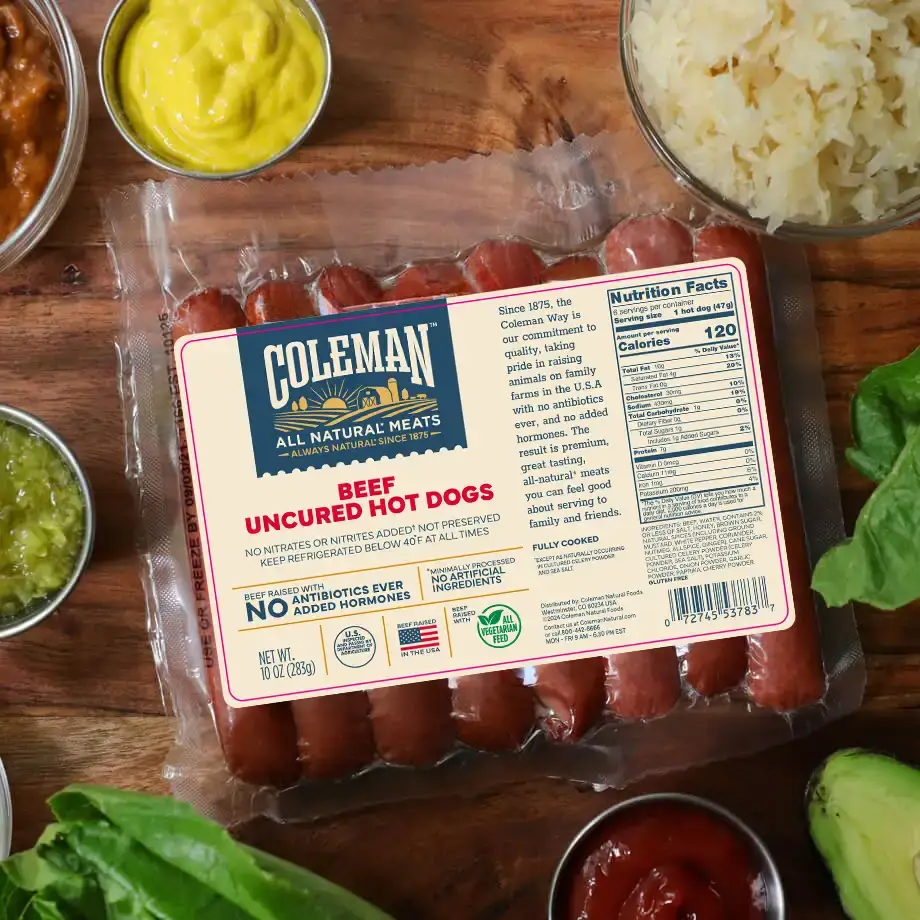While it’s common knowledge that going heavy on the salt shaker increases sodium intake, this nutrient also hides in many processed and packaged foods as well.
Whether you’re following a strict low-sodium diet or just looking to decrease your daily sodium intake, it can be helpful to learn just how much of this essential nutrient is in your favorite foods. So let’s start with the all-American classic, the hot dog!
We’re going to cover how much sodium lies unsuspectingly in these family favorites… as well as how you can enjoy them as part of a balanced diet.
Are Hot Dogs High in Sodium?
The exact amount of sodium depends on the specific hot dog you choose. No hot dog on the market is considered a low-sodium food – defined by the FDA as a food that provides less than 5% of your daily value of sodium per serving. In fact, some hot dogs actually provide more than 20% of your daily value of sodium per serving, classifying them as high-sodium foods.
Just as ingredients vary between types of hot dogs, so does the sodium content. One Coleman Natural hot dog contains 430 milligrams of sodium, or 19% of the recommended daily value. However, other hot dogs contain 710 or even 770 milligrams of sodium!
These differences illustrate the importance of reading nutrition labels so you can choose high-quality products for you and your family.

Why Is Sodium Added to Hot Dogs?
Now that you know how much sodium is in hot dogs, let’s explore why it’s there in the first place.
Much of the sodium in hot dogs comes from the same type of salt you sprinkle on your french fries or mix into your baked goods. No matter if you choose sea salt, Himalayan pink salt, or kosher salt, the product is almost entirely made up of sodium chloride. The only differences between these types of salt is their place of origin, as well as the presence of trace minerals in them.
Producers add salt to hot dogs to enhance the flavor and help preserve the meat. Along with salt, some hot dogs contain sodium-containing additives such as sodium nitrite and sodium phosphate. Producers often use sodium nitrate to cure hot dogs and other types of meat. However, these meats can also be cured using natural ingredients such as cultured celery powder and sea salt. For instance, Coleman Natural combines sea salt with cultured celery powder to naturally cure our hot dogs rather than using additives.
Sodium phosphate is often used in hot dogs to retain moisture, but it isn’t necessary and doesn’t affect quality or flavor. Just take one bite of a juicy Coleman Natural hot dog to realize this for yourself!

How Hot Dog Sodium Content Compares to Other Foods
Now that you know the amount of sodium in hot dogs, let’s look into how these fun favorites compare to the sodium content of other packaged and prepared foods.
On average, canned soup has 700 mg of sodium per one cup serving. That means if you eat a standard 16-ounce can of soup, you’re consuming more than half the recommended amount of daily sodium! While you may think soup is an anomaly, this isn’t the case. Prepared macaroni and cheese has an average of 759 milligrams of sodium per serving, while frozen or refrigerated biscuits have an average of 538 milligrams per serving.
And it’s not just savory foods either; the amount of instant pudding mix required to make a half cup of pudding contains 360 milligrams of this nutrient.
So how do hot dogs compare to these foods? As we previously mentioned, it really depends on the type of hot dog you eat. However, if you choose to enjoy a Coleman Natural hot dog, you’ll consume only 260 milligrams of sodium per serving.
Are Hot Dogs Healthy to Eat?
First off, it’s important to remember that not all hot dogs are the same! That means the type of hot dog you choose will impact how these beloved foods can fit into a healthy diet.
Coleman Natural uncured beef hot dogs are made from beef trimmings, salt, and seasonings – they never contain fillers, binders, or alternate proteins. However, this isn’t the case for all hot dog brands.

Read some hot dog ingredient labels and you may find additives like corn syrup, modified corn starch, artificial sweeteners, and nitrites. High levels of sodium aren’t the only things to keep a close watch on. And while the package probably won’t advertise this, keep in mind that the animals from which the meat was sourced may have been given antibiotics or growth hormones.
By choosing Coleman Uncured Beef Hot Dogs, you and your family can still enjoy these foods as part of a balanced diet, while also feeling good about the farming practices that got them to your table.
Enjoy All-Natural Hot Dogs
As we mentioned above, Coleman Uncured Beef Hot Dogs contain less sodium than many other types of hot dogs. But they also feature many other benefits!
All of our hot dogs are made from beef sourced from animals that were never given antibiotics or hormones. Additionally, our hot dogs are cured with cultured celery powder and sea salt, rather than added nitrites or nitrates.
“My kids love, and I mean love, Coleman Uncured Beef Hot Dogs, because they taste delicious, and I feel good about serving them because they are 100% Beef Hot Dogs that are free of added nitrates, nitrites, and any artificial ingredients. I also love that they are sourced from American family farmers who never use antibiotics or hormones.” – @FromScratchwithMaria
But don’t think this absence of ingredients means lackluster flavor! Whether you’re hosting a backyard barbeque or cooking up some Chili Cheese Dog Pockets, our all-beef hot dogs will still provide the savory taste you love.
To learn more about your favorite meats, read these article next:


